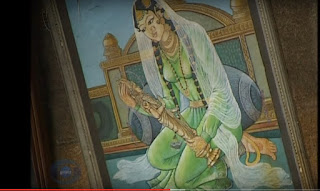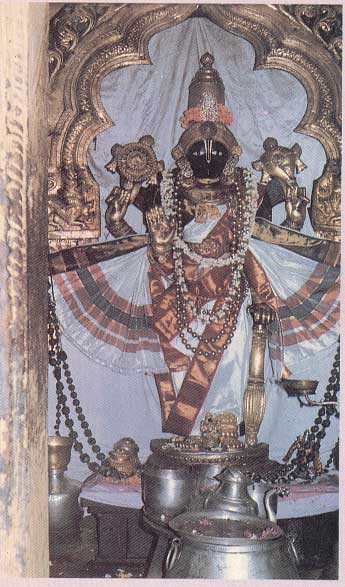GITA 10.24
 |
| SRI KALYANI NACHIYAR IN SESHA VAHANAM |
Sri Thayar never parts with the Lord. As the name suggests, the Lord is Sri Tirunarayanan, and the Divine Couple can never be separated. Here, Sri Thayar is seated between the feet of the Lord. Today's [29th August 2008] lecture is from the sannidhi of Sri Yadhugiri Nachiyar or Sri Kalyani Nachiyar.
 |
| SRI YADUGIRI NACHIYAR IN SANNIDHI |
This is a separate sannidhi. Who is the Sri Thayar seated in between the feet of the Lord? This is unique to this Kshetram. We saw that the daughter of Emmadurayan was deeply in love with the Lord; but when Swami Ramanuja requested, the Lord Sri Ramapriya came to him and sat on his lap. Thereby, the Lord got the name Sri Yatiraja Sampat Kumara or Sri Chellapillai. Swami Ramanuja brought the idol of Sri Ramapriya to this place. But that girl [daughter of Emmadurayan] could not bear her separation from the Lord. So she insisted that she also would accompany the Lord and Eammadurayan had to agree and sent troops and servants along with her. As they all come to enter Tirunarayanapuram, Swami Ramanuja thought what to do when once the idol was installed in the garbhagruha as none could go near the idol. But she appeared to be a very great devotee, and Bhakti is very important. So, it is said that Swami Ramanuja converted her to a small idol and installed at the feet of the Lord. This way she never parts the Lord. But we are in the sannidhi of Sri Maha Lakshmi, here called as Sri Yadhugiri Nachiyar. Her glory is very much, perhaps greater than the Lord. It is said that in ancient days, Sri Thayar was seated upright with an appearance of independence to grant all, anything they wanted, on Her own. Just opposite Her sannidhi is the sannidhi of Swami Ramanuja. Since the Lord is regarded as the Son of Swami Ramanuja, he is in a way father-in-law of Sri Thayar! As is the custom, in the presence or in front of a father-in-law, the Daughter-in-law, has to show rrespect and may not show Her independent Nature. So, now She graces all devotees with a bowed appearance. Moolavar is Sri Yadhugiri Nachiyar and Utsavar is Sri Kalyani Nachiyar. Right hand is showing abhaya and left hand is indicating Her Divine Feet. There can be no doubt that after a bath in Kalyani pushkarini, if we worship Sri Kalyani Nachiyar, our lives will be full of auspicious [kalyana] functions. Swami Alavandar says kanthaste purushottama [कान्तस्ते ]. He is so much attracted to Her, that He would do anything She demanded. Acharyas say ingitha paradheena [इन्गिथ पराधीन ], which means He waits for Her approval by Her eyes [கண் பார்வை ]. She grants wealth and Moksham, just for a salute, with folded hands, to Her. Swami Parashara Bhatta says that Sri Thayar is bending Her face down in shy. The shy is not beacause She is near Her Husband, the Lord; nor the shy is because She is in front of Her father-in-law, Swami Ramanuja; but She feels shy for not granting more than Moksham to the devotee!
We will now see sloka 23. In slokas 21 and 22, the Lord described groups of Four in each sloka, saying He was the leader among various groups. Now sloka 23:
rudranam sankaras casmi
vitteso yaksha-rakshasam
vasunam pavakas casmi
meruh sikharinam aham
"Of all the Rudras I am Lord Shiva, of the Yakshas and Rakshasas I am the Lord of wealth [Kuvera], of the Vasus I am fire [Agni], and of mountains I am Meru."
Another Four groups are mentioned here. Rudranam = among [Eleven] Rudras, sankara =Sankara, asmi = I [Sri Krishna] am. Vittesa = Leader of wealth [Kubera], yaksha-rakshasam = in Yaksha and Rakshasas, vasunam = among the [Eight] Vasus [அஷ்ட வசுக்கள் ], pavaka = Pavaka, sikharinam = among the [mountain] peaks, meru =Meru, aham =I [Sri Krishna] am. Sam + karothi = sankara. He who gives comfort. The Lord says thet lord Shiva is His body. During Tirunangur visit it was mentioned about Eleven Rudras. Adityas are Twelve. Vasus are Eight. And, Aswini devas are Two. So, 11+12+8+2 =33, which is mentioned by Sri Andal in Her Tiruppavai pasuram, "muppatthu moovar amararku" [முப்பத்து மூவர் அமரர்க்கு முன் சென்று ] [19th verse]. By mentioning that He is Sankara among the Rudras, we should clearly understand that the Lord and lord Shiva are not one and the same. Because if we interpret it that way, the Lord says He is Sama veda or mountain peak Meru. Does it mean that Sama veda and Lord are same? Are Meru and the Lord one and same? Just like we interpreted there, that Sama veda is body to the Lord; or, Moon was body to the Lord, here also we should understand that lord Shiva is body to the Lord. The Lord is the Cause, and all others are effects. So swaroopa aikyam [स्वरुप ऐक्यम ] - same person - is not mentioned. We should realise the sarira-atman relationship. Because of this, Alwar says that he did not know how to call the Lord - as Shiva or as Brahma? Because all are His body. Normally, the name of the body applies to atman. When an atman resides in a body in a birth, that body gets a name. When we call that name the atman inside that body commands the body to turn and answer. Body as such has no capacity to recognise names or is inanimate or Achit. All attributes to the body, apply to to the atman. So whatever we say of Moon or Kubera, it refers to their inner atman, Sriman Narayana. Here we may get a doubt. All these days we have been differentiating between atman and body. How can it be said that all attributes to body refer to atman? We say the plant has blossomed. Dog barks, etc. Surely, the body of the dog by itself can not bark. Plant by itself is an inanimate object. What we mean is that the atman in dog's body barks. Atman in plant is blossoming. Only sarira-atman bhavam has been mentioned by the Lord. Kubera is also an Yaksha and so when the Lord says He is Kubera, He is Kubera among Yakshas; but Kubera is not a rakshasa and so here, only the leadership of rakshasa is implied. This is sambandha samaniyasti category. Sikharam means peak of mountain. Meru and Himachalam are different. Meru has been praised by many poets. It is said that Meru mountain is gold and its peaks are of diamonds. In another palce He is going to say that in sthavaras He is Himalaya; and so Himalaya and Meru are different.
 |
SRI THAYAR (Moolavar and Utsavar)
(continued)
|















